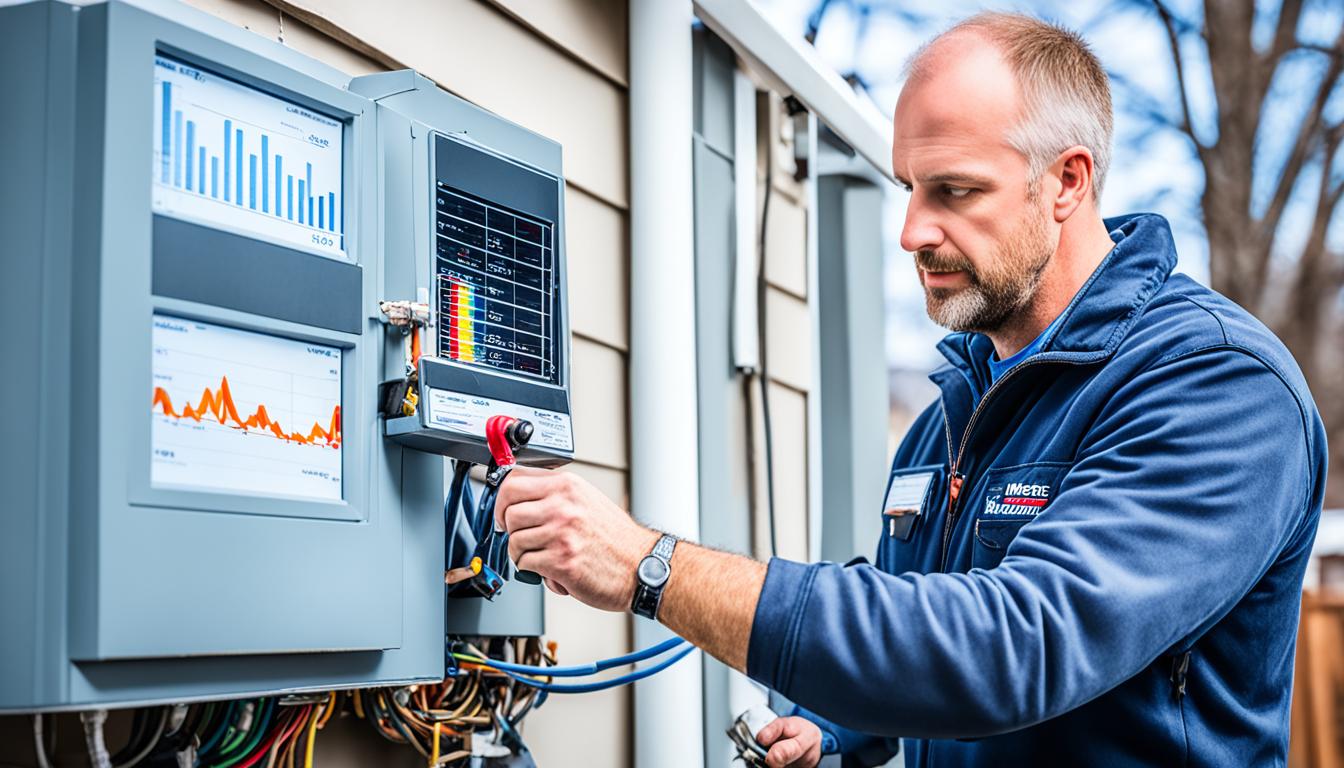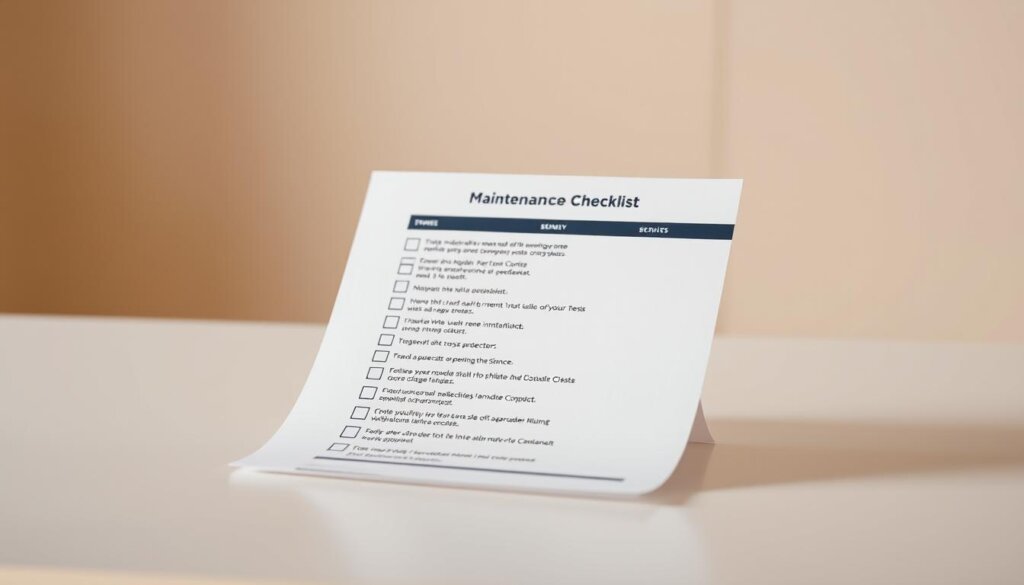Ignoring small fixes now could cost you 100 times more later. That’s not a guess—it’s what national data shows. For every dollar spent on basic care, property owners avoid triple-digit repair bills. Yet most people wait until problems snowball.
Think about your own home or rental. When was the last time you checked gutters before fall rains? Or inspected HVAC systems before summer heat? These tasks aren’t glamorous, but they’re the armor that protects your investment.
I’ve seen how proactive care keeps tenants happy too. A leaky roof fixed in spring means no midnight panic calls during storms. Clean air filters mean fewer complaints about stuffy rooms. It’s not just about saving money—it’s about keeping people comfortable year-round.
Digital tools make this easier than ever. Automated alerts nudge you when it’s time to service appliances or seal windows. No more forgotten tasks buried in sticky notes. You’ll tackle issues before they escalate, and tenants notice that reliability.

Key Takeaways
- Preventative care reduces repair costs by up to 100x
- Timely updates boost tenant satisfaction and retention
- Weather-related risks drop with scheduled checkups
- Automated systems simplify tracking recurring tasks
- Consistent communication builds trust with renters
Understanding the Importance of Seasonal Maintenance
Regular upkeep is the shield your home needs to fight nature’s wear and tear. Think of wood siding that warps in summer humidity or concrete driveways cracking under winter frost. These aren’t just nuisances—they’re silent budget killers waiting to strike.
How Maintenance Impacts Property Longevity
I’ve watched identical houses on my street age differently. One owner replaced caulking yearly, while another ignored peeling paint. Guess which property needed a $12,000 exterior overhaul last spring? Materials expand and contract with weather shifts—without care, small gaps become water highways.
Last year, a client avoided $8,000 in repairs by fixing loose roof shingles before rainy season. That’s the power of timing. Your HVAC system alone lasts 5-7 years longer with filter changes and coil cleanings. It’s like changing your car’s oil—skip it, and the engine fails early.
My Experience with Preventative Care
When I bought my first rental, I learned this lesson the hard way. A $40 gutter cleaning could’ve prevented $1,200 in basement damage from ice dams. Now, I schedule inspections every 6 months. Tenants stay happier when they’re not dealing with leaks or broken AC units.
The secret? Know your home’s weak spots. My coastal properties need more attention on salt-resistant coatings. Mountain cabins? Roof reinforcements for snow load. Tailored care plans beat generic checklists every time.
Seasonal Maintenance Reminders Checklist: A Smart Approach
Ever forget to winterize pipes or clean dryer vents? I did—once. Now I use digital checklists that act like a personal assistant for my properties. They remember what I can’t, from gutter cleanings to furnace inspections.

Automating Tasks for Simplicity
Tools like Manifestly Checklists changed my workflow. They ping me when it’s time to check smoke detectors or flush water heaters. No more scrambling before storms—the system tracks every task automatically. Last summer, this saved me from missing AC servicing deadlines across 3 rentals.
Tenants get alerts too. When they see gutter cleaning scheduled, they know I’m proactive. It builds trust faster than any lease agreement.
Customizing Checklists to Fit My Property Needs
My beach house needs different care than my mountain cabin. Salt air eats metal fixtures, while heavy snow strains roofs. I tweak checklists for each property’s quirks using location-specific items. A 1920s craftsman gets extra plumbing checks, while a modern condo focuses on HVAC filters.
I group tasks by urgency: red flags first, nice-to-dos later. This way, I tackle leak risks before repainting fences. Digital platforms let me drag-and-drop priorities as needs change—no paper shuffling required.
Sharing editable lists with contractors cuts call time. They mark jobs done in real time, and I get peace of mind. It’s like having eyes on every property without driving there.
Spring Maintenance Strategies
Winter’s thaw reveals what harsh weather left behind. Last March, I found a maple branch crushing a gutter—missed during fall prep. Spring isn’t just about flowers; it’s damage control season. Tackle these tasks now, and your home breathes easier all summer.
Exterior Inspection and Upkeep After Winter
Walk your property like a detective. Look for cracks in foundations or gaps around windows—entry points for water. Check roof edges for curled shingles that survived ice but won’t handle spring rains. Last year, I spotted a single loose gutter bracket that could’ve caused $800 in water damage.
Clear debris from drains and test downspouts with a hose. Clogged gutters turn into waterfalls during April showers. Trim bushes away from siding to prevent mold traps. My rule: if a plant touches the house, it gets a haircut.
Refreshing Indoor Systems and Safety Checks
Swap HVAC filters before switching from heat to AC. Dust buildup from winter makes systems work 30% harder. I mark my calendar for professional coil cleanings—dirty coils can spike energy bills.
Open every window to air out stale rooms. Wash tracks to prevent jams and check for drafts. Test smoke detectors while you’re at it—I replace batteries during daylight saving time shifts. A chirping alarm at 3 AM teaches you quick.
Deep clean carpets now before pollen season hits. Vacuum fridge coils too—your appliance will thank you with lower repair bills.
Summer Preservation Tactics
Summer’s heat tests your home’s defenses like no other season. Sweltering temperatures strain cooling systems, while sudden storms threaten landscaping and roofs. I’ve found balancing these challenges keeps tenants comfortable and repair bills low.

Cooling Systems and Smart Landscaping
Your AC works overtime in July. Last year, a simple filter cleaning boosted airflow by 40% in my rental. Now I schedule professional tune-ups every May—refrigerant checks and coil cleaning prevent mid-summer breakdowns. Smart thermostats help tenants save energy without sacrificing comfort.
Landscaping needs finesse too. Overgrown shrubs block airflow to condenser units, while thirsty plants spike water bills. I switched to drought-resistant grasses and timed irrigation for early mornings. Bonus: trimmed tree limbs reduce storm damage risks.
Heat Defense and Storm Readiness
I learned the hard way when a heatwave warped window seals in my beach house. Now I apply UV-protective films and check attic insulation yearly. For storms, clear gutters weekly—a clogged one caused $1,500 in foundation damage during a flash flood.
Secure outdoor furniture before forecasts turn rough. Last month, a client avoided patio umbrella missiles by stowing items early. I also test sump pumps and grade soil away from foundations. Tenants sleep better knowing their home can handle summer’s mood swings.
Fall Maintenance Planning
Crisp autumn air signals it’s time to armor up your home against winter’s bite. Last October, I watched a neighbor’s clogged gutter spill rainwater into their foundation—a $2,500 lesson I won’t forget. Fall isn’t just about pumpkin spice; it’s your last chance to fix vulnerabilities before freezing temps arrive.
Weatherproofing and Gutter Clean-Up
Gutters packed with leaves become ice dams waiting to happen. I use a telescoping wand to clear debris without ladder risks. Always check downspouts drain away from the foundation—a client saved $1,800 in basement repairs by redirecting one last fall.
Seal gaps around windows and doors with foam weatherstripping. I learned the hard way when a drafty chimney flue doubled my heating bill. Now I caulk cracks wider than a nickel and replace worn door sweeps annually.
Enhancing Interior Insulation and Safety
Your heating system works hardest in winter. I schedule furnace inspections every September—a $120 tune-up caught cracked heat exchangers before carbon monoxide risks arose. Check attic insulation depth too; adding 6 inches cut my energy costs by 15%.
Test smoke detectors while replacing chimney flue caps. I swap batteries during Halloween decor setup—it’s easier to remember. A quick vacuum of dryer vents prevents fires, and sealing ductwork boosts efficiency when you need it most.
Winterizing Your Property Effectively
Bitter cold doesn’t just chill bones—it tests your home’s defenses. Last January, I watched a client’s uninsulated pipe burst during a -10°F snap. The $4,000 cleanup bill taught me: preparation isn’t optional. Freezing weather targets weak spots like unheated crawl spaces and aging roofs.
Insulating Pipes and Roofs to Prevent Damage
Wrap exposed pipes with foam sleeves—especially in attics and basements. I use thermostatically controlled heat tape for tricky spots. One winter, this saved my mountain cabin’s plumbing when temps plunged to -15°F. Don’t forget outdoor spigots! Disconnect hoses and install frost-proof faucet covers.
Roofs need love too. After heavy snow collapsed a neighbor’s shed, I started checking for loose shingles every November. Reinforce weak trusses and trim overhanging branches. A pro inspection costs less than replacing waterlogged ceilings.
Setting Up Emergency and Snow Removal Plans
Lock in snow plow services by Thanksgiving—contractors book fast. I keep rock salt stocked and mark walkways with reflective stakes. Tenants get a PDF guide: how to shut off water mains if pipes freeze. Last year, this saved three units from flooding.
Test furnaces before the first freeze. I replace filters monthly and install CO detectors near bedrooms. For backup, portable heaters with auto-shutoff features keep rooms livable during outages. Clear communication prevents panic when storms hit.
Leveraging Automation & Digital Checklists
Remembering every maintenance task felt impossible until I discovered automation tools. Now, my properties practically manage themselves. Digital systems handle the mental load, letting me focus on bigger priorities while keeping tenants happy.
Why Manifestly Changed My Workflow
This platform became my secret weapon for efficiency. Setting up recurring tasks takes minutes—filter replacements, gutter cleanings, HVAC checks. The system pings me and my team automatically. Last winter, it reminded us to winterize 14 outdoor faucets we’d overlooked.
Real-Time Tracking for Peace of Mind
Watch progress unfold like a live map. When contractors mark roof inspections complete, I see it instantly. No more “Did they fix the leak?” texts. This transparency cuts confusion and builds trust with renters.
Custom checklists adapt to each property’s needs. My beach house list includes monthly corrosion checks, while mountain cabins track snow load limits. Tenants even get tailored alerts—like AC prep tips before heatwaves.
Analyzing past data helps too. After spotting repeated plumbing issues in older units, I shifted inspection schedules. Now we catch problems 3 weeks faster on average. Automation isn’t just convenient—it’s making my properties better over time.
Conclusion
Protecting your property doesn’t require superhuman effort—just smart systems. I’ve seen how $1 spent on routine care stops $100 repair bills dead in their tracks. It’s not about working harder, but smarter.
Automated checklists became my game-changer. They handle reminders for furnace checks, gutter cleanings, and safety tests so I don’t have to. Last year, this system caught a cracked window seal before winter drafts hit—saving me from icy nights and angry tenants.
Consistency builds trust. When renters see you fixing leaks promptly or replacing air filters on schedule, they stick around longer. I’ve renewed 80% of leases this way, simply by showing I value their comfort.
Start small. Pick one task—like inspecting carbon monoxide detectors or clearing dryer vents—and make it routine. Tools exist to help you scale without stress. Your future self (and bank account) will thank you.
See how FieldAx can transform your Field Operations.
Try it today! Book Demo
You are one click away from your customized FieldAx Demo!
FAQ
How does regular upkeep help my property last longer?
I’ve found that consistent care stops small issues—like leaks or cracks—from turning into costly repairs. Checking gutters, roofs, and HVAC systems yearly prevents weather-related wear and keeps everything running smoothly.
What’s the easiest way to manage my yearly checklist?
I automate reminders using tools like Manifestly Checklists. Setting digital alerts for tasks like gutter cleaning or filter changes saves time and ensures I never miss critical steps, especially before harsh weather hits.
Why should I prioritize gutter cleaning in fall?
Clogged gutters cause water buildup, which can damage roofs, siding, and foundations. I always clear leaves and debris in autumn to avoid ice dams in winter and protect my home’s exterior from costly water damage.
How do I prepare my cooling system for summer?
I schedule professional HVAC inspections each spring. Cleaning coils, checking refrigerant levels, and replacing filters boost efficiency. Sealing windows and adding shade also helps reduce strain on the system during heatwaves.
What’s your top tip for winterizing pipes?
Insulating exposed pipes is a must! I use foam sleeves or heat tape to prevent freezing. Shutting off outdoor faucets and keeping indoor temps above 55°F during cold snaps avoids bursts and expensive water damage.
Are smart thermostats worth it for energy efficiency?
Absolutely! I installed a Nest thermostat to automate temperature adjustments. It cuts heating/cooling costs by adapting to my schedule and providing usage reports, which helps me spot inefficiencies quickly.
How often should I test smoke detectors?
I test mine monthly and replace batteries twice a year—during daylight saving time shifts. Upgrading to 10-year sealed detectors reduces hassle, and syncing them with carbon monoxide alarms adds extra safety.
What’s the best way to handle storm prep?
I trim trees near my roof each spring and secure outdoor furniture before storms. Installing surge protectors and keeping an emergency kit with flashlights, blankets, and a generator ensures I’m ready for power outages or severe weather.
Author Bio
Co-Founder & CMO at Merfantz Technologies Pvt Ltd | Marketing Manager for FieldAx Field Service Software | Salesforce All-Star Ranger and Community Contributor | Salesforce Content Creation for Knowledge Sharing






